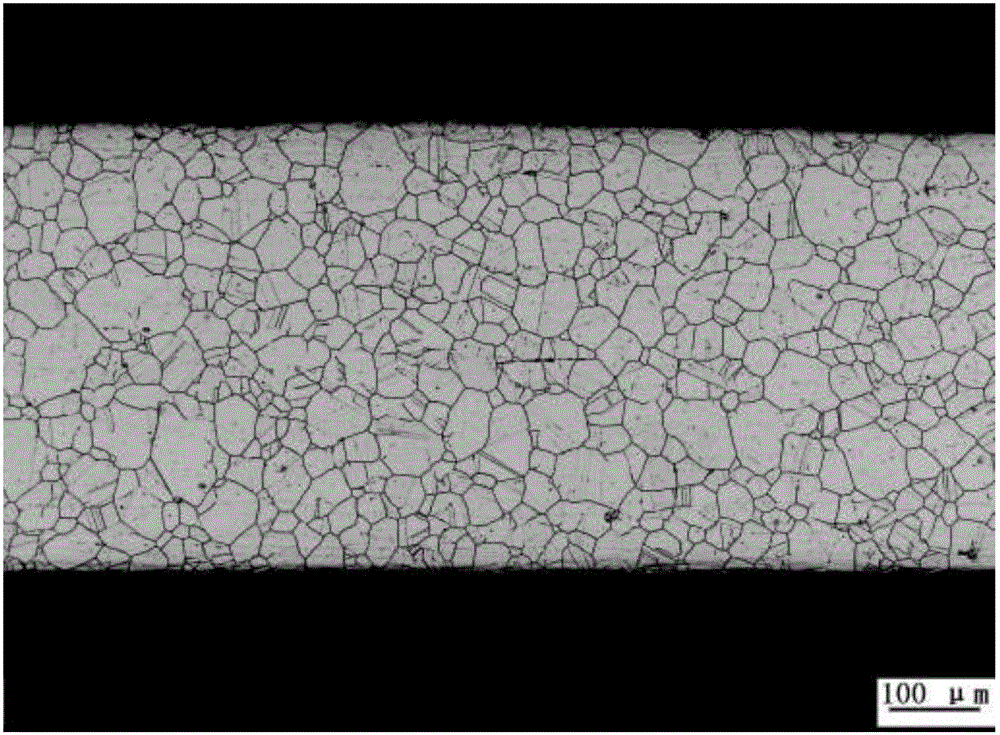Test method of metallographic structure of austenitic stainless steel pipe for nuclear power
A technology of austenitic stainless steel and metallographic structure, which is applied in the inspection field of metallographic structure of austenitic stainless steel tubes for nuclear power, can solve the problems of not being able to obtain clear ferrite, and achieve the effect of avoiding severe corrosion and easy operation
- Summary
- Abstract
- Description
- Claims
- Application Information
AI Technical Summary
Problems solved by technology
Method used
Image
Examples
Embodiment 1
[0028] In this embodiment, the metallographic structure of 316L stainless steel with an outer diameter of 10.5 mm and a wall thickness of 0.5 mm is inspected. The specific method includes the following steps:
[0029] Step 1. Machining a metallographic observation plane on an austenitic stainless steel tube for nuclear power, then grinding the machined metallographic observation plane on a metallographic grinder, and washing away the sand grains on the metallographic observation plane after grinding; The grinding process is to use 150# and 700# metallographic water sandpaper to grind step by step successively, and the grinding direction is rotated 90° when changing the grain size sandpaper to grind each time, so as to ensure that the last grinding trace is completely eliminated;
[0030] Step 2. Place the metallographic observation plane of the austenitic stainless steel pipe for nuclear power that has been washed out of the sand in step 1 on the polishing machine, and use Cr ...
Embodiment 2
[0037] In this embodiment, the outer diameter is 9.8mm, and the metallographic structure of 304L stainless steel with a wall thickness of 0.4mm is inspected. The specific method includes the following steps:
[0038] Step 1. Machining a metallographic observation plane on an austenitic stainless steel tube for nuclear power, then grinding the machined metallographic observation plane on a metallographic grinder, and washing away the sand grains on the metallographic observation plane after grinding; The grinding process is to use 150# and 700# metallographic water sandpaper to grind step by step successively, and the grinding direction is rotated 90° when changing the grain size sandpaper to grind each time, so as to ensure that the last grinding trace is completely eliminated;
[0039] Step 2. Place the metallographic observation plane of the austenitic stainless steel pipe for nuclear power that has been washed out of the sand in step 1 on the polishing machine, and use Cr 2...
Embodiment 3
[0046] In this embodiment, the outer diameter is 11 mm, and the metallographic structure of 308L stainless steel with a wall thickness of 0.7 mm is inspected. The specific method includes the following steps:
[0047] Step 1. Machining a metallographic observation plane on an austenitic stainless steel tube for nuclear power, then grinding the machined metallographic observation plane on a metallographic grinder, and washing away the sand grains on the metallographic observation plane after grinding; The grinding process is to use 150# and 700# metallographic water sandpaper to grind step by step successively, and the grinding direction is rotated 90° when changing the grain size sandpaper to grind each time, so as to ensure that the last grinding trace is completely eliminated;
[0048] Step 2. Place the metallographic observation plane of the austenitic stainless steel pipe for nuclear power that has been washed out of the sand in step 1 on the polishing machine, and use Cr ...
PUM
| Property | Measurement | Unit |
|---|---|---|
| Granularity | aaaaa | aaaaa |
Abstract
Description
Claims
Application Information
 Login to View More
Login to View More - R&D
- Intellectual Property
- Life Sciences
- Materials
- Tech Scout
- Unparalleled Data Quality
- Higher Quality Content
- 60% Fewer Hallucinations
Browse by: Latest US Patents, China's latest patents, Technical Efficacy Thesaurus, Application Domain, Technology Topic, Popular Technical Reports.
© 2025 PatSnap. All rights reserved.Legal|Privacy policy|Modern Slavery Act Transparency Statement|Sitemap|About US| Contact US: help@patsnap.com



